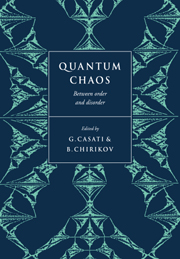Book contents
- Frontmatter
- Contents
- Preface
- Acknowledgments
- Introduction
- Part One Classical chaos and quantum localization
- Part Two Atoms in strong fields
- Part Three Semiclassical approximations
- Semiclassical theory of spectral rigidity
- Semiclassical structure of trace formulas
- ħ-Expansion for quantum trace formulas
- Pinball scattering
- Logarithm breaking time in quantum chaos
- Semiclassical propagation: how long can it last?
- The quantized Baker's transformation
- Classical structures in the quantized baker transformation
- Quantum nodal points as fingerprints of classical chaos
- Chaology of action billiards
- Part Four Level statistics and random matrix theory
- Index
ħ-Expansion for quantum trace formulas
Published online by Cambridge University Press: 07 May 2010
- Frontmatter
- Contents
- Preface
- Acknowledgments
- Introduction
- Part One Classical chaos and quantum localization
- Part Two Atoms in strong fields
- Part Three Semiclassical approximations
- Semiclassical theory of spectral rigidity
- Semiclassical structure of trace formulas
- ħ-Expansion for quantum trace formulas
- Pinball scattering
- Logarithm breaking time in quantum chaos
- Semiclassical propagation: how long can it last?
- The quantized Baker's transformation
- Classical structures in the quantized baker transformation
- Quantum nodal points as fingerprints of classical chaos
- Chaology of action billiards
- Part Four Level statistics and random matrix theory
- Index
Summary
Abstract
We present and review several results on the semiclassical quantization of classically chaotic systems. Using Feynman path integrals and the stationary phase method, we develop a new semiclassical theory for quantum trace formulas in classically hyperbolic systems. In this way, we obtain corrections to the Gutzwiller-Selberg trace formulas like asymptotic series in powers of the Planck constant. The coefficients of these series are expressed in terms of Feynman diagrams. We illustrate our method with the calculation of resonances for the wave scattering on hard disks.
Introduction
In recent years, important advances have been made in our understanding of the dynamical behaviours which are intermediate between the classical and the quantal regimes [1-7]. The general context of these advances is the current research in mesoscopic physics and chemistry, which is bridging the gap between the microscopic and the macroscopic worlds. Systems which have been particularly studied in this respect include highly excited or reacting atoms and molecules as well as nanometric semiconductor devices, among many other systems [8-19].
In this chapter, we consider quantum mechanics in the semiclassical regime where the actions of the dynamical processes in question are larger than the Planck constant. This eikonal or short-wavelength assumption allows us to solve the Schrödinger equation using information on the classical orbits of a system and more especially on their periodic orbits. In this way, we can understand in detail how classical mechanics emerges from quantum mechanics.
- Type
- Chapter
- Information
- Quantum ChaosBetween Order and Disorder, pp. 385 - 404Publisher: Cambridge University PressPrint publication year: 1995

